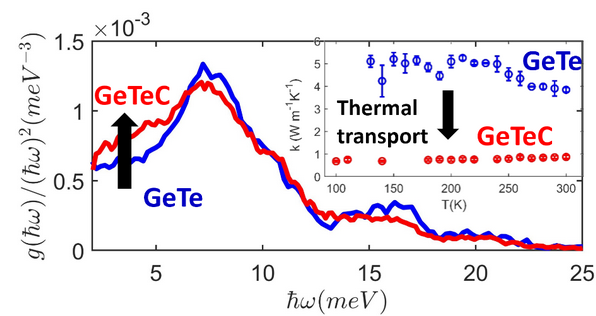
Quand une nanostructure se comporte comme un verre
When a nanostructure behaves like a glass
Valentina Giordano, Stéphane Pailhès et Regis Debord, (équipe Energie), en collaboration avec des collègues de Grenoble, ont publié un article intitulé " Glass-like phonon dynamics and thermal transport in a GeTe nano-composite at low temperature " dans la revue Small.
Valentina Giordano, Stéphane Pailhès and Régis Debord (Energy team), in collaboration with colleagues from Grenoble, published an article entitled " Glass-like phonon dynamics and thermal transport in a GeTe nano-composite at low temperature " in the journal Small.
Un défi sociétal majeur aujourd’hui est la réduction des dissipations de chaleur et sa récupération. Pour cela, des matériaux à basse conductivité thermique mais avec de bonnes propriétés électroniques sont recherchés. Le Graal est un matériau qui transporte la chaleur comme un verre. Dans ces derniers, le désordre diffuse fortement les particules élémentaires responsables du transport thermique par les vibrations des atomes, les « phonons ». Ceci donne lieu à des propriétés vibrationnelles spécifiques, telles que la présence d’un excès de modes dans la densité d’état vibrationnelle à basse énergie par rapport à la loi de Debye, qui sont à l’origine d’une basse conductivité thermique faiblement dépendante de la température.
Les auteurs ont démontré ici que une dynamique vibrationnelle et transport de chaleur de type verre peuvent être obtenus dans un nanocomposite fait de matériaux avec un fort contraste de propriétés. C’est le cas d’un nanocomposite fait de GeTe et carbone amorphe, d’intérêt pour la microélectronique. Les auteurs ont mis en évidence une basse conductivité thermique faiblement dépendante de la température, ainsi que l’apparition d’un excès d’états dans densité d’états vibrationnelle, mesurée par diffusion inélastique des rayons x à ESRF. Le contraste élastique est à l’origine d’une forte diffusion des phonons et du comportement de type verre.
Voir aussi un article de synthèse [ici]
Les auteurs ont démontré ici que une dynamique vibrationnelle et transport de chaleur de type verre peuvent être obtenus dans un nanocomposite fait de matériaux avec un fort contraste de propriétés. C’est le cas d’un nanocomposite fait de GeTe et carbone amorphe, d’intérêt pour la microélectronique. Les auteurs ont mis en évidence une basse conductivité thermique faiblement dépendante de la température, ainsi que l’apparition d’un excès d’états dans densité d’états vibrationnelle, mesurée par diffusion inélastique des rayons x à ESRF. Le contraste élastique est à l’origine d’une forte diffusion des phonons et du comportement de type verre.
Voir aussi un article de synthèse [ici]
A major challenge today is reducing heat dissipations and recycling waste heat. For this, materials with a low thermal conductivity but good electronic properties are generally sought. The holy Grail is a material able to transport heat as glasses. In these latter, disorder strongly scatters the quasi-particles of the atomic vibrations responsible for heat transport, phonons. The consequence is a glass-specific vibrational dynamics, with an excess of modes in the low energy phonon density of states with respect to the Debye law, which is dubbed responsible for a low and weakly temperature dependent thermal conductivity.
The authors have shown here that a glass-like vibrational dynamics and heat transport can be obtained in a nanocomposite made of materials with a strong contrast of properties. This is the case of a nanocomposite made of GeTe and amorphous carbon, of interest in microelectronics. The authors have evidenced a low and weakly temperature dependent thermal conductivity, as well as the arising of an excess of states in the low energy phonon density of states, as measured by inelastic x ray scattering at ESRF. The strong elastic contrast is at the origin of a strong phonon scattering and the arising of glass-like behavior.
For more information and broader context, see [here]
The authors have shown here that a glass-like vibrational dynamics and heat transport can be obtained in a nanocomposite made of materials with a strong contrast of properties. This is the case of a nanocomposite made of GeTe and amorphous carbon, of interest in microelectronics. The authors have evidenced a low and weakly temperature dependent thermal conductivity, as well as the arising of an excess of states in the low energy phonon density of states, as measured by inelastic x ray scattering at ESRF. The strong elastic contrast is at the origin of a strong phonon scattering and the arising of glass-like behavior.
For more information and broader context, see [here]
 The vibrational density of states of GeTe (blue) is compared with the one of the nanocomposite GeTeC (red) after division by the energy squared. GeTe follows the Debye law, while this is not the case for GeTeC, like in glasses. Inset : thermal conductivity in GeTe and GeTeC, showing the strong reduction and different temperature dependence in the latter.
The vibrational density of states of GeTe (blue) is compared with the one of the nanocomposite GeTeC (red) after division by the energy squared. GeTe follows the Debye law, while this is not the case for GeTeC, like in glasses. Inset : thermal conductivity in GeTe and GeTeC, showing the strong reduction and different temperature dependence in the latter. 
















